Increase Website Engagement with More Prominent On-Site Search
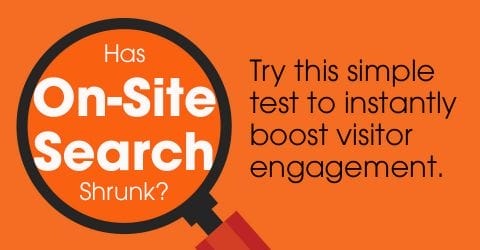
Has internal on-site search shrunk?
It appears it has. Eight of the top ten software companies have reduced their on-site search to a tiny icon.
Why? Responsive websites are the norm now and website traffic is largely mobile. It appears these companies aim to reduce the clutter for mobile visitors.
Is this a smart move? Is on-site search less important than it once was?
ToTheWeb monitors its clients Google Analytics accounts and we’ve noticed after the change to responsive website design on-site searches have declined.
I was curious to learn more and hypothesized that expanding and improving our on-site search mechanism—on desktop and mobile—might increase engagement. So, as we often do, we ran an experiment. We expanded the site search icon to prominently feature a search input field and, after four months, took a close look at what happened.
The results surprised us.
ON-SITE SEARCH

Search soared. When on-site search was made more visible, the number of searches climbed by 439%. In the same 4-month time period, visits that did not use site search increased by only 10%.

Did we create a better user experience? Did the change inspire visitors to take the actions we wanted?
Here are some more of our findings:
Time on-site increased. Visitors stayed on the site 110% longer when they used on-site search compared to when they did not.
SITE SEARCH OVERVIEW
 Pageviews increased. Pageviews, following an on-site search, increased by 45%.
Pageviews increased. Pageviews, following an on-site search, increased by 45%.
Higher goal completion increased. Our site achieved a 242% increase in goal completions.
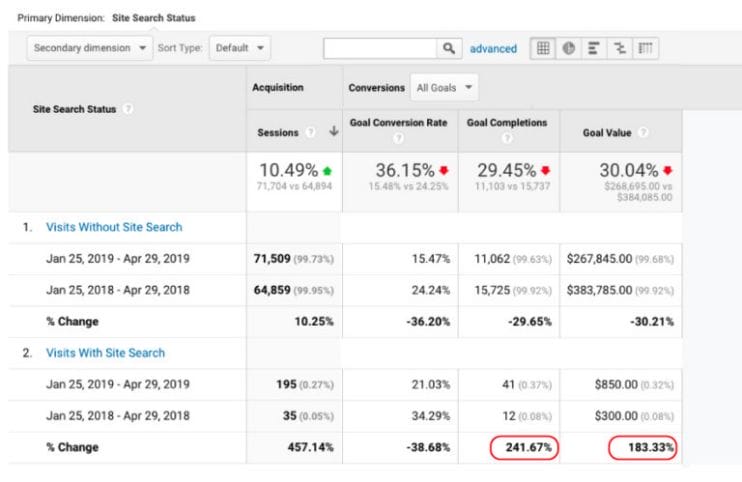
Bounce rate decreased.
When you make your content easier to find – people will stay longer. Your bounce rate will improve.

With the exception of just one page, our bounce rate across the site declined by an average of 25%. Other factors could impact bounce rates, but this is a notable improvement.
While only a small percentage of your users will use on-site search, giving your visitors what they want, when they want it produces a high pay-off in terms of engagement.
You can see where we’re going with this. When prospects arrive on your website, you want to make it easy for them to find what they’re looking for. Higher engagement means more leads and sales.
Expand On-Site Search - try this test on your site to see engagement skyrocket. Click To TweetOn-site search has a larger impact on mobile devices
On our site, we saw a very pronounced spike for site search usage on mobile. Look at the before-and-after results for mobile vs. desktop.

Next, look at the different results when we expanded the navigation bar to include a prominent search field.
SITE SEARCH CLICKS ON MOBILE
Mobile shows a 200% increase in site search usage.

Heat maps reveal far more focus on the search mechanism when we changed from a simple icon to full-fledged search field.
What about the all-important time-on-site metric?
SITE SEARCH USAGE MOBILE VERSUS DESKTOP
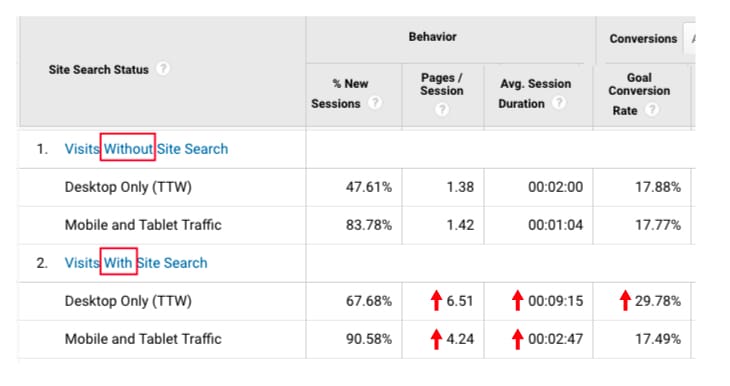
Our data indicated visitors that used on-site search spent far more time on our site and visited more pages.
How large websites can benefit from site search
TIBCO is a great example of a website with a massive number of pages—around 25,500 URLs.

Shockingly, the site offers no search functionality. How will visitors quickly find what they seek. It appears TIBCO relies solely on the high-level navigation offered in its menu. Users are bound to be frustrated.

In fact, you’d have an easier time finding content on the TIBCO site by using Google, which offered a search field for the site. Perhaps that’s no coincidence.
Where should you place site search on your page?
Site search has its conventions, so you’ll want give your visitors the experience they expect by placing the search mechanism atop the page and use the magnifying glass icon. Grayed-back text is often placed in the field so as to prompt the user to enter the products they seek.
“Provide an easily identifiable search box in the upper right-hand corner of the page, with an open text-field accompanied by a Search button.”
NNGroup.com
Ecommerce websites tend to get it right…
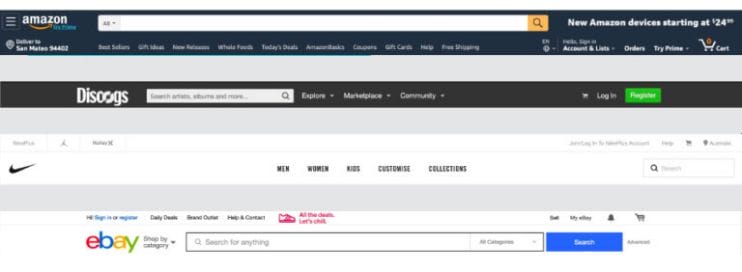
Learn more about ecommerce site search in 12 Site Search Best Practices.
Take advantage of internal site search analytics
GOOGLE ANALYTICS SITE SEARCH “USAGE” REPORT
Goal Conversion Rate is higher when visitors use site search.

Offering on-site search affords you the opportunity to gather valuable analytics. You’ll likely see the new users, especially, are apt to use the search field.
In most cases, your analytics will reveal site search has a positive effect on goal conversion. Look at the numbers above. The goal here is to download a tool on the ToTheWeb website, which of course helps us expand our mailing list.
GOOGLE ANALYTICS INTERNAL SITE SEARCH METRICS
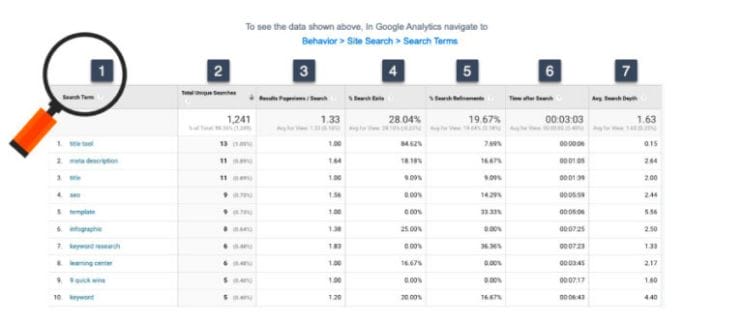
The columns in the report above include:
- Search Term—Every search term visitors entered are revealed.
- Total Unique Search—Shows the total number of times your site search was used.
- Results Pageviews/Search—This column shows the number of pages viewed after visitors ran a search.
- % Search Exists—This means: Search Exits / Total Unique Searches.
- Search Refinement—Shows the number of times a user searched again (refining, narrowing down, changing search query) immediately after performing a search.
- Time After Search—The time visitors stay on a page after searching. Note that it’s generally far longer than your average time on page for users who don’t search.
- Average Search Depth—Average number of results pages people viewed after completing an on-site search.
Use the data to increase engagement
You can use this data to understand what content people can’t easily find on your website. In the screenshot above you can see in row 7 that when a visitor searched for “keyword research” they stayed on the results page for over 7 minutes. They also refined their search and eventually visited additional pages after their search.
Use the “advanced” filter to group together high-value keywords to better analyze results.

You’ll see a long list of search terms, but you can create a Secondary Dimension to see the page the search originated from. Most search originates on the homepage because it typically receives the highest number of pageviews.
Your on-site search analytics will enable you to discover the topics people are most interested in, and possibly, identify how you can add relevant content to satisfy the user.
USE GOOGLE’S SITE SEARCH DIMENSIONS TO FURTHER REFINE RESULTS
Add a secondary Dimension to see the page the search term was generated from.

Design a helpful site search results page
Of course, it’s important to design your site search results pages in a way that makes it easy for users to quickly find content and products.

ACI’s search results page above not only delivers the results but also features advanced search filters and makes it easy to conduct another search.

Contrast this search results page to the one shown prior. It’s messy and confusing. The results are mostly URLs, which aren’t descriptive. Visitors are far more likely to bounce.
How to setup on-site search in Google Analytics
- Sign in to your Analytics account.
- Click Admin, and navigate to the view in which you want to set up Site Search.
- In the View column, click View Settings.
- Under Site Search Settings, set Site Search Tracking to ON.
Useful Resources
- Andy Crestodina offers site search customization instructions for configuring site search in Google Analytics
- Barry Feldman wrote a helpful blog post here
- NNGroup Recommendations for Designing with the Magnifying-Glass Icon
We encourage you to run a similar test on your website properties. We’d love to hear about your results. Email us
We make content audits painless
Large websites tend to grow messy and inefficient over time. Outdated or low-quality quality content rarely gets any visibility and not only adds bloat to your site, but negatively affects your UX and SEO success.
So, if you haven’t done it before, it’s time to conduct a content audit to identify these ghost town pages, and then, revise or remove them.
It's content inventory time - start your own audit!
Content Inventory & Audit » Step-by-Step Guide to Running Your 1st Audit
Rosemary Brisco
AI Training Videos
AI Consulting and Training
Master today’s most effective productivity tools.
ToTheWeb ensures your route to capitalizing on the immense power of AI is fast and efficient. Our AI consulting and training programs will quickly enable your marketing team to adopt solutions to optimize operations and boost performance.
Learn about our generative AI and ChatGPT consulting and training programs


